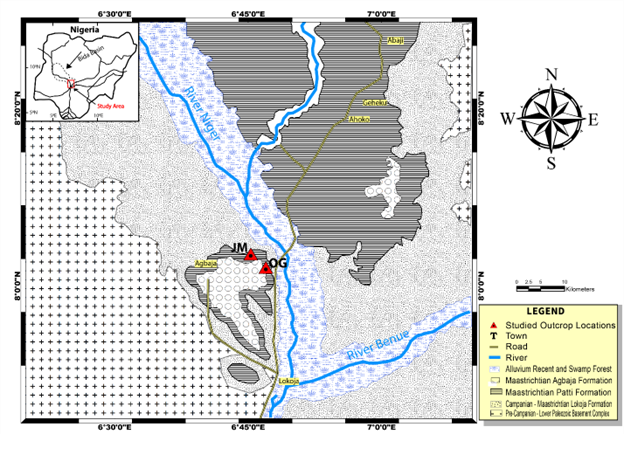Patti formation shales at Agbaja Plateau: A geochemical window into the provenance and tectonic setting history of the Southern Bida Basin, Nigeria
Keywords:
Shales, Geochemistry, Provenance, Bida, PattiAbstract
Agbaja Plateau is one of the mesas that dotted the topography of north centrally located Bida Basin. Seventeen shale samples from the exposed Maastrichtian Patti Formation at Agbaja Plateau were analyzed using x-ray fluorescence (XRF) and inductive coupled plasma mass spectrophotometry (ICPMS) with the aim of unroofing the provenance, weathering and paleotectonic history of the basin. The provenance-sensitive elemental ratios; Al2O3/TiO2 , Cr/Ni, Th/Cr, La/Sc, Th/Sc and Th/Co and the binary diagrams of Al2O3 vs TiO2, TiO2 vs Zr, reveal that the shales originated from felsic source rock. The Light rare earth elements (LREE) enrichment, Flat heavy rare earth elements (HREE) model, a negative Eu anomaly and positive Ce anomalies, and La/Yb-REE bivariate diagram also reveal sediments derivation predominantly from felsic protolith. The plots of SiO2 versus K2O/Na2Oand Ti/Zr versus La/Sc, and Ti/Zr–La/Sc, Th-Sc-Zr/10, Th–Co-Zr/10, and La-Th-Sc discrimination diagrams show that the shales plotted in the passive margin. The Zr/Sc and Th/Sc ratios and low ICV values show first cycle recycling with heavy mineral enrichment. LREE, with flat HREE distributions, as well as the normalized Gd/Yb and La/Yb enrichment indicate similarity with the post-Archean Australian Average Shales (PAAS). The high values of chemical index of weathering, chemical index of alteration and Plagioclase Index of Alteration indicate that the protolith experienced strong chemical weathering. In conclusion, the study suggest that the investigated shales were derived mainly from felsic source rocks and deposited in passive margin setting similar to the adjacent sedimentary basins in Nigeria and west Africa.

Published
How to Cite
Issue
Section
Copyright (c) 2025 olusola J. Ojo, Suraju A. Adepoju, Ayodeji Awe, Kehinde A. Alalade

This work is licensed under a Creative Commons Attribution 4.0 International License.
How to Cite
Similar Articles
- S. A. Adepoju, O. J. Ojo, O. Olaniyan, T. E. Bamidele, I. S. Usman, Sedimentological and weathering signature investigation of claystones from Northern Bida Basin, Central Nigeria , Journal of the Nigerian Society of Physical Sciences: Volume 7, Issue 3, August 2025
- A. Y. Jimoh, M. B. Saadu, A. A. Adetoro, J. Ajadi, T. Issa, U. Issa, Sedimentological and geochemical evaluation of sandstones of the Ilaro formation, Dahomey Basin, Southwestern Nigeria : Insights into paleoenvironments, provenance, and tectonic settings , Journal of the Nigerian Society of Physical Sciences: Volume 6, Issue 1, February 2024
- Shola C. Odewumi, Mineralization, geochemical signatures, and provenance of stream sediments on the Jos Plateau, Northcentral Nigeria , Journal of the Nigerian Society of Physical Sciences: Volume 6, Issue 4, November 2024
- A. Abdulrahim, M. D Shehu, E Yisa, Z. A. Ishaq, Mathematical Models and Comparative Analysis for Rice and Soya Bean Irrigation Crop Water Needs: A Case Study of Bida Basin Niger State, Nigeria , Journal of the Nigerian Society of Physical Sciences: Volume 3, Issue 4, November 2021
- F. C. Ugbe, O. E. Ominigbo, A. O. Akano, Tectonic Setting of the Syenite Around Igarra, Southwestern Nigeria: Constraints from Geochemistry , Journal of the Nigerian Society of Physical Sciences: Volume 5, Issue 1, February 2023
- K. A Haruna, J. K. Raji, A. Y. Jimoh, J. A. Adeoye, O. O. Alu, A. A. Badmus, B. Garba, Biostratigraphy and paleoenvironment studies of shales from Owan-1 Well, Niger Delta Basin, Nigeria , Journal of the Nigerian Society of Physical Sciences: Volume 7, Issue 3, August 2025
- C. Gopi, Edward Anand E, A. Charles, C. Manivannan, S .Ponsadai Lakshmi, A. Jose, M. Muthiyan, Physico-Chemical and Trace Metal Analysis in Groundwater of Nagapattinam Region in Nagapattinam District of Tamilnadu State , Journal of the Nigerian Society of Physical Sciences: Volume 5, Issue 2, May 2023
You may also start an advanced similarity search for this article.







